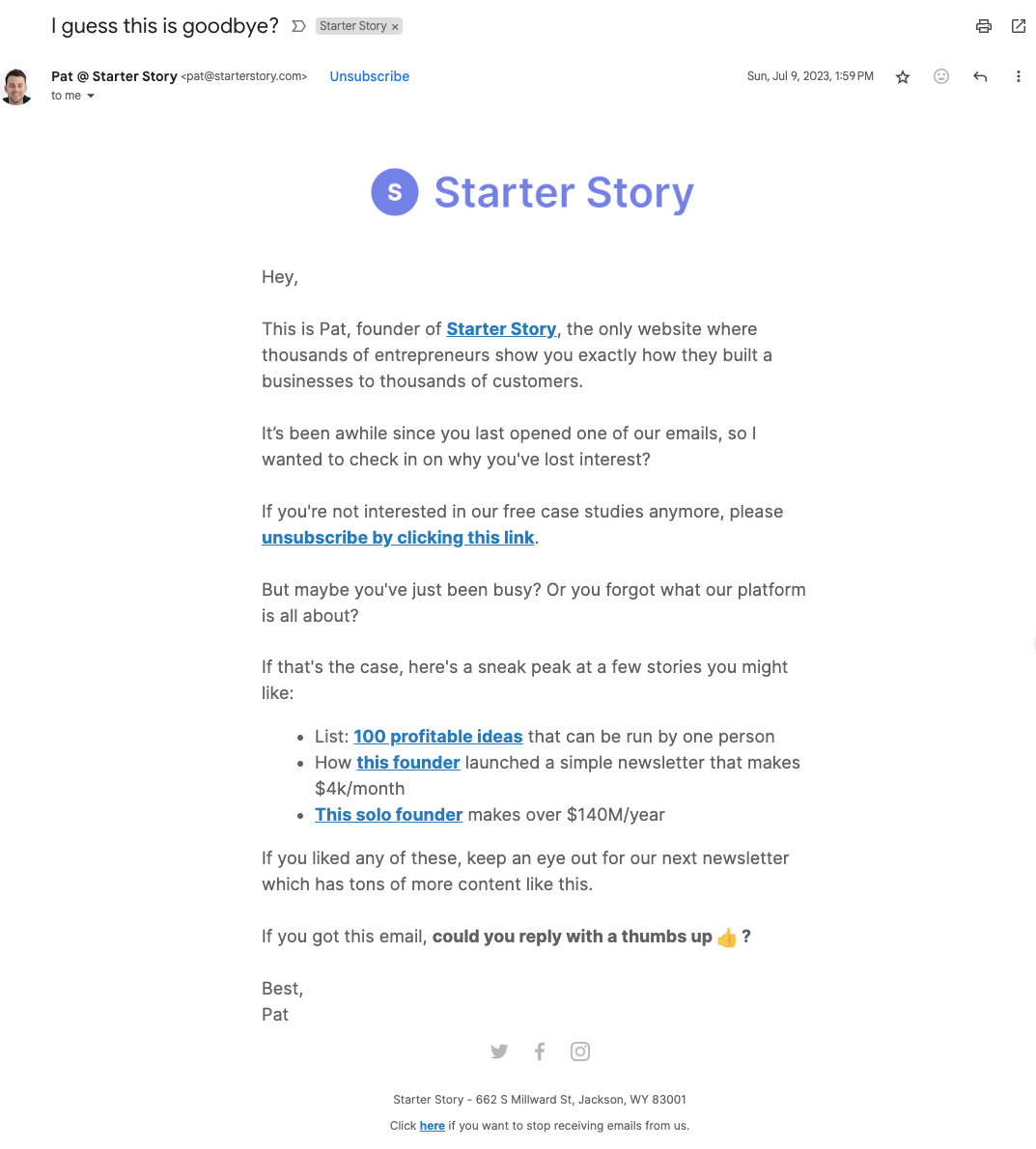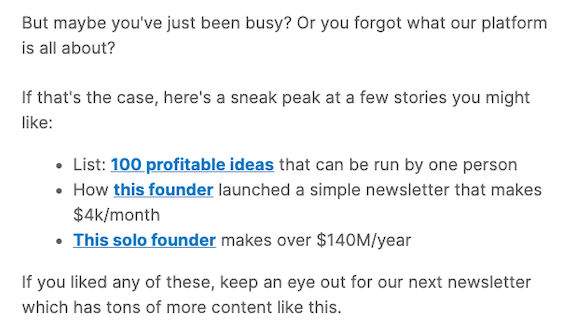Starter Story is an online platform that provides a wealth of resources and inspiration for entrepreneurs and small business owners. The site offers a large collection of interviews, case studies, and guides, featuring successful business owners who share their experiences, strategies, and advice.
The platform was founded by Pat Walls, who started Starter Story as a way to help people start businesses by learning from the experiences of others.
In this breakdown, we’ll analyze Starter Story’s re-engagement email to uncover key strategies and tactics that make it effective.

Subject Line – “I guess this is goodbye?”
This subject line aims to re-engage subscribers who haven’t interacted with the emails for a while. It’s designed to prompt an emotional response that encourages the reader to open the email.

It suggests a finality, a possible end of a relationship, which can prompt the recipient to open the email out of concern or curiosity. It’s a powerful motivator because people naturally dislike the feeling of missing out and may open the email to see what they could potentially be losing.
The ‘From’ name showing “Pat @ Starter Story” adds a personal touch, suggesting that the message comes directly from an individual rather than a faceless organization. This can make the email feel more personal and thus increase the likelihood of it being opened.
Including a profile picture of Pat, presumably the founder, next to the email in the inbox further personalizes the email. It’s a visual cue that can help the email stand out in a crowded inbox and reinforce the personal connection. This element of humanization can help build trust and rapport with the recipients, as they see a real person behind the business, which can be especially effective in community-oriented platforms like Starter Story.
Ideas For You to Write Such Effective Subject Lines
Here are some ideas for subject lines that aim to rekindle the relationship with subscribers:
- “We miss you, [Name]! Here’s what you’ve missed…”
- “Is this goodbye, [Name]? We hope not.”
- “[Name], your exclusive access is about to expire!”
- “Feeling left out? Check what’s new, [Name]!”
- “Don’t go, [Name]! See what you could be missing…”
- “[Name], we made this just for you — don’t miss it!”
- “Last chance to see what everyone’s talking about, [Name]!”
Each of these lines is crafted to address the subscriber directly, often by name, and implies that their absence is noted and that there’s something of value waiting for them.
The key is to make the recipient feel valued and missed while also hinting at exclusive content or opportunities they may lose access to if they don’t re-engage.
Section 1: Re-engagement and Value Proposition
This section tactfully addresses the issue of inactivity and offers a straightforward way for disengaged subscribers to either reconnect with the platform or to opt out, thereby improving the overall health of the email list.

The opening “Hey,” is informal and friendly, attempting to rebuild the connection with the recipient.
Pat introduces himself as the founder of Starter Story, which adds credibility and a personal touch. Mentioning the unique value proposition of Starter Story as the “only website where thousands of entrepreneurs show you exactly how they built businesses” provides a quick reminder of the site’s purpose and value.
By acknowledging the recipient’s inactivity (“It’s been a while since you last opened one of our emails”), Pat is transparently addressing the possibility of disengagement, which can prompt a reflective response from the reader.
The direct question about why the recipient has lost interest is a straightforward approach to engage in a dialogue and possibly receive feedback.
The final line provides a clear and easy way for the recipient to unsubscribe, which respects the recipient’s inbox and choice. It is also a good practice to maintain a clean and engaged email list.
Section 2: Content Highlights and Engagement Request
This section’s goal is to showcase the value Starter Story provides and to encourage the recipient to re-engage with the platform by demonstrating what they’re missing out on and by requesting a low-effort interaction.

It teases with high-impact content (e.g., “100 profitable ideas”, a founder making $4k/month, a solo founder making over $140M/year) to pique the recipient’s interest and remind them of the value that Starter Story offers. Highlighting specific successful stories can rekindle interest and encourage the recipient to revisit the website.

The line “If you liked any of these, keep an eye out for our next newsletter” encourages the recipient to stay subscribed for more valuable content. This is a subtle way to nudge inactive subscribers to look forward to future communications.
Asking for a simple response (“Could you reply with a thumbs up 👍?”) is a clever way to gauge the recipient’s engagement without asking for too much effort. It also humanizes the interaction by using an emoji, which can feel more informal and friendly.
Ending with “Best, Pat” gives the email a personal sign-off from the founder, which can reinforce the personal connection and the authenticity of the message.
Analysis From a Design Perspective
The design of the email appears to be minimalistic and user-friendly, focusing on readability and direct communication. Here are a few design elements that stand out:
- Typography and Colors: The email uses a simple and clean font, likely for ease of reading. The use of bold text and blue highlights draw attention to key elements like “100 profitable ideas” and “this solo founder,” guiding the reader’s eye to the most important parts.
- Whitespace: There seems to be ample whitespace around the text, which avoids clutter and makes the content less overwhelming. This can help in keeping the reader’s attention focused on the message itself.
- Emphasis on Links: The links are prominently displayed, likely in a different color and perhaps underlined to stand out from the rest of the text. This is a common practice to encourage users to click through to additional content.
Potential Areas For Improvement
- Personalized Greetings and Content: Personalization can substantially enhance engagement by making the recipient feel recognized and valued. Using data to personalize emails means going beyond just inserting the recipient’s name. It could involve referencing their last activity with Starter Story or mentioning topics they have shown interest in.
For example, if they have read case studies related to SaaS businesses in the past, the email could say, “Since you’ve enjoyed our SaaS stories, here’s something you might find intriguing…”
- Testimonials and Success Metrics: A brief yet impactful testimonial or a striking success metric from one of the case studies could serve as powerful social proof.
For instance, including a quote from a successful entrepreneur who credits Starter Story for their growth, along with a notable statistic (e.g., “Join 10,000+ entrepreneurs who increased their revenue by 50% within a year of using our insights”), can provide compelling reasons for the recipients to stay subscribed and engage with the content.
- Detailed Feedback via Surveys: While a thumbs-up is a quick engagement tool, it provides limited insight into the subscriber’s preferences. A short survey link can collect more nuanced feedback, helping to understand subscriber needs better and tailor future content accordingly.
The survey can be simple, with questions like “What topics are you interested in?” or “How can we add more value to your Starter Story experience?”
10 Takeaways For Email Marketers From Starter Story’s Re-Engagement Email
- Emotional Subject Lines: Use subject lines that evoke emotion and a sense of urgency to improve open rates.
- From Personalization: Include a personal name and photo in the sender’s information to create a sense of familiarity.
- Direct Questions: Pose direct questions to re-engage subscribers who haven’t been active.
- Content Teasers: Highlight exclusive content or success stories to entice readers to engage.
- Easy Engagement: Offer simple ways for subscribers to provide feedback or show interest, like a thumbs-up reply.
- Clean Design: Utilize a clean, straightforward design with strategic use of whitespace and color for emphasis.
- Feedback Collection: Incorporate surveys or interactive elements to collect meaningful feedback from subscribers.
